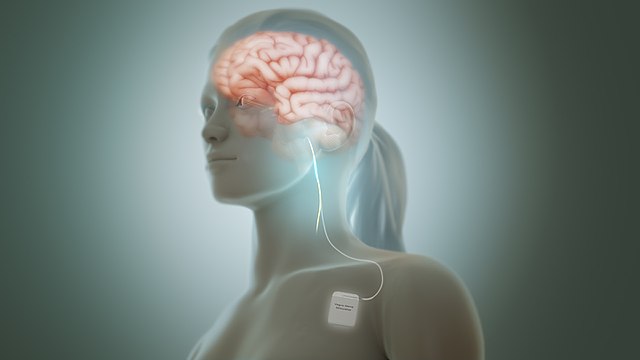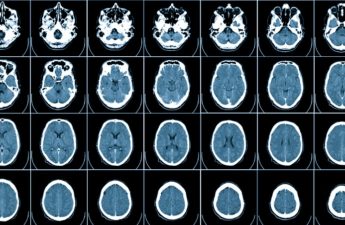
Theresa Larkin, University of Wollongong
On social media and in wellbeing circles, people have been talking about the vagus nerve a lot. In fact, we have two vagus nerves – a left and a right – and their optimal functioning is essential for good physical and mental health.
Many social media posts describe ways to reset the vagus nerves to reduce stress and increase calm. These mostly focus on yoga, meditation, deep breathing and cold plunges.
But the vagus nerves also play a part in why socialising, sex and sports are good for our health and wellbeing.
Our rest-and-digest-and-restore system
The sympathetic nervous system produces our fight-or-flight response to perceived threats. The vagus nerves are part of the parasympathetic nervous system, which does the opposite: rest, digest and restore.
The sympathetic nervous system increases heart and breathing rates, slows down digestion and lowers the immune response. Stimulation of the vagus nerves reduces heart rate, promotes healthy digestion and metabolism, increases blood flow to organs and reduces inflammation.
It is healthy to activate our sympathetic nervous system during exercise and short-term stress. But ongoing stimulation of the sympathetic nervous system is not healthy.
The parasympathetic nervous system via the vagus nerves is the counterbalance to our stress response. It makes us more calm, relaxed and sociable.
The vasovagal response is an over-reaction of the vagus nerves to counterbalance a stress. This is when an excessive drop in blood pressure and heart rate causes a person to feel dizzy or faint.
The wandering nerve
Vagus means wandering in Latin and is where the words vagrant, vagabond and vague come from. The name reflects the long pathway and extensive branching of our vagus nerves. These are the tenth cranial nerves, the longest of the 12 pairs of cranial nerves that connect the brainstem and the body.
The vagus nerves run down the neck where they are about 5mm in diameter. They travel into the thoracic (chest) cavity and send branches to the heart and lungs, then pass through the diaphragm to innervate nearly all the abdominal organs.
We mostly hear of the effects of the vagus nerves on our organs, such as reducing heart rate. However, about 80% of vagus nerve fibres carry information from organs back to our brain. This forms part of the bidirectional gut-brain axis. This can explain the “butterflies in your stomach” when you feel nervous, and why gastrointestinal problems can cause anxiety and depression.
Can you measure the health of vagus nerves?
It is not possible to directly measure vagal tone (the level of activity in the nerves). Instead, heart-rate variability is used as a surrogate measure of vagus nerve activity. This is the slight beat-to-beat differences in heart rate that occur naturally, related to breathing. When you inhale, your heart rate speeds up. When you slowly exhale, it slows down.
Vagus-nerve stimulation slows the heart rate but increases heart-rate variability. These are both healthy because they indicate higher parasympathetic and lower sympathetic activation. A lower heart rate indicates the heart is working efficiently. Higher heart rate variability suggests the body is more relaxed.
Many wearable devices measure heart rate and heart-rate variability and can be a useful way to monitor vagal tone.
So is there any science to back the vagal nerve hacks online?
Yoga practice and slow diaphragmatic breathing with a long exhalation stimulate the vagus nerves directly or via relaxation. Cold-water immersion on the face or neck stimulates the vagus nerves via a reflex of the skin’s nerves.
Singing and humming can increase our vagal tone because the vagus nerve innervates our larynx (voicebox).
There are also claims simple eye movements can reset the vagus nerve. This has not been tested scientifically. But there is an oculocardiac reflex where activation of the eye muscles stimulates the vagus nerves. Pressure on the eyes also stimulates this reflex. This might be why one natural reaction when we feel stressed is to press our eyes.
Craniosacral therapy is a form of osteopathy that involves gentle touch and movements around the base of the skull and the sacrum. This has been shown to reduce cortisol and increase parasympathetic activity.
Carotid sinus massage can also be used clinically to increase vagus nerve activation and lower a high heart rate. Light massage of the carotid artery in the neck stimulates blood pressure receptors, which causes reflex activation of the vagus nerves to reduce heart rate. This should only be done by a clinician or with professional advice, for 5 to 10 seconds and never both sides at once, which can cause fainting.
Social connection and feeling safe
Polyvagal theory suggests positive social communication and feeling safe increases vagus nerve activity. This promotes healthy growth and restoration activities in our body and increases positive emotions.
The vagus nerves have a role in social communication because they are linked with our facial expressions and voice. Smiling and being smiled at can stimulate our vagus nerves.
Sport, sex and slowing down
Sports and sex are both associated with high sympathetic nervous system activation. When intimacy or competitive sport happen in a safe, social and supportive environment, the vagus nerves are also stimulated. Having a short-term stress response followed by the counterbalancing recovery effects of vagus nerves is healthy.
Slowing down with others, such as lying down next to a friend on a picnic blanket and looking at the clouds, also stimulates the vagus nerves. This is a safe way to reduce our energy requirements and rest while also being socially connected.
Whether it’s through mindfulness, paced breathing, sports, sex or simply smiling, increased vagal tone is important for good health and wellbeing. There is a lot of hype online and some of it may be over the top. But reduced stress and greater relaxation are safe for everyone and have positive effects for our body and brain.
Theresa Larkin, Associate professor of Medical Sciences, University of Wollongong
This article is republished from The Conversation under a Creative Commons license.
Read the original article.


